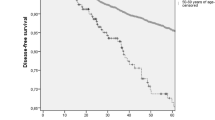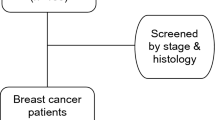Abstract
Young breast cancer patients are more likely than old patients to experience ipsilateral breast tumor recurrence (IBTR) after breast conserving surgery (BCS). However, the pathological processes underlying this relationship have not been elucidated. We investigated the effect of young age on IBTR in a Korean cohort of women with different molecular subtypes of breast cancer. We analyzed data of 2,102 consecutive breast cancer patients who underwent BCS and post-surgical radiation therapy (RT) at two Korean institutions between 2000 and 2005. Patients were classified as young (≤40 years; N = 513) or old (>40 years; N = 1,589). Breast cancer subtype was determined by estrogen receptor (ER), progesterone receptor (PR), and HER2. Median follow-up duration was 61 months. The 5-year IBTR rate was 3.4% in young patients and 1.1% in old patients (P < 0.001). Univariate analysis indicated that IBTR rate in young patients with luminal A and HER2 subtypes was significantly greater than in old patients with these subtypes (P = 0.015 and P < 0.001, respectively). Multivariate analysis, which used luminal A subtype in old patients as reference, indicated that HER2 subtype in young patients was associated with increased risk of IBTR (hazard ratio, HR = 12.24; 95% CI: 2.54–57.96). Among old patients, HER2 subtype was not associated with increased IBTR. In conclusion, young women had a higher rate of IBTR after BCS and RT than old women. This difference is mainly among women with HER2 subtype. Aggressive local control and adjuvant therapy should be considered for young women with HER2 subtype breast cancer.



Similar content being viewed by others
References
Colleoni M, Rotmensz N, Peruzzotti G, Maisonneuve P, Orlando L, Ghisini R et al (2006) Role of endocrine responsiveness and adjuvant therapy in very young women (below 35 years) with operable breast cancer and node negative disease. Ann Oncol 17:1497–1503
Han W, Kim SW, Park IA, Kang D, Youn YK, Oh SK et al (2004) Young age: an independent risk factor for disease-free survival in women with operable breast cancer. BMC Cancer 4:82
O’Rourke MT, Ellison PT (1993) Age and prognosis in premenopausal breast cancer. Lancet 342:60
Han W, Kang SY (2010) Relationship between age at diagnosis and outcome of premenopausal breast cancer: age less than 35 years is a reasonable cut-off for defining young age-onset breast cancer. Breast Cancer Res Treat 119:193–200
Ahn SH, Son BH, Kim SW, Kim SI, Jeong J, Ko SS et al (2007) Poor outcome of hormone receptor-positive breast cancer at very young age is due to tamoxifen resistance: nationwide survival data in Korea—a report from the Korean Breast Cancer Society. J Clin Oncol 25:2360–2368
Bollet MA, Sigal-Zafrani B, Mazeau V, Savignoni A, de la Rochefordiere A, Vincent-Salomon A et al (2007) Age remains the first prognostic factor for loco-regional breast cancer recurrence in young (<40 years) women treated with breast conserving surgery first. Radiother Oncol 82:272–280
Jones HA, Antonini N, Hart AA, Peterse JL, Horiot JC, Collin F et al (2009) Impact of pathological characteristics on local relapse after breast-conserving therapy: a subgroup analysis of the EORTC boost versus no boost trial. J Clin Oncol 27:4939–4947
Bartelink H, Horiot JC, Poortmans P, Struikmans H, Van den Bogaert W, Barillot I et al (2001) Recurrence rates after treatment of breast cancer with standard radiotherapy with or without additional radiation. N Engl J Med 345:1378–1387
Botteri E, Bagnardi V, Rotmensz N, Gentilini O, Disalvatore D, Bazolli B et al (2010) Analysis of local and regional recurrences in breast cancer after conservative surgery. Ann Oncol 21:723–728
Zhou P, Gautam S, Recht A (2007) Factors affecting outcome for young women with early stage invasive breast cancer treated with breast-conserving therapy. Breast Cancer Res Treat 101:51–57
Komoike Y, Akiyama F, Iino Y, Ikeda T, Akashi-Tanaka S, Ohsumi S et al (2006) Ipsilateral breast tumor recurrence (IBTR) after breast-conserving treatment for early breast cancer: risk factors and impact on distant metastases. Cancer 106:35–41
Perou CM, Sørlie T, Eisen MB, van de Rijn M, Jeffrey SS, Rees CA et al (2000) Molecular portraits of human breast tumours. Nature 406:747–752
Sørlie T, Perou CM, Tibshirani R, Aas T, Geisler S, Johnsen H et al (2001) Gene expression patterns of breast carcinomas distinguish tumor subclasses with clinical implications. Proc Natl Acad Sci USA 98:10869–10874
Albert JM, Gonzalez-Angulo AM, Guray M, Sahin A, Strom EA, Tereffe W et al (2010) Estrogen/progesterone receptor negativity and HER2 positivity predict locoregional recurrence in patients with T1a, bN0 breast cancer. Int J Radiat Oncol Biol Phys 77:1296–1302
Voduc KD, Cheang MCU, Tyldesley S, Gelmon K, Nielsen TO, Kennecke H (2010) Breast cancer subtypes and the risk of local and regional relapse. J Clin Oncol 28:1684–1691
Nguyen PL, Taghian AG, Katz MS, Niemierko A, Abi Raad RF, Boon WL et al (2008) Breast cancer subtype approximated by estrogen receptor, progesterone receptor, and HER-2 is associated with local and distant recurrence after breast-conserving therapy. J Clin Oncol 26:2373–2378
Antonini N, Jones H, Horiot JC, Poortmans P, Struikmans H, Van den Bogaert W et al (2007) Effect of age and radiation dose on local control after breast conserving treatment: EORTC trial 22881-10882. Radiother Oncol 82:265–271
Anders CK, Fan C, Parker JS, Carey LA, Blackwell KL, Klauber-DeMore N et al (2011) Breast carcinomas arising at a young age: unique biology or a surrogate for aggressive intrinsic subtypes? J Clin Oncol 29:e18–e20
Anders CK, Hsu DS, Broadwater G, Acharya CR, Foekens JA, Zhang Y et al (2008) Young age at diagnosis correlates with worse prognosis and defines a subset of breast cancers with shared patterns of gene expression. J Clin Oncol 26:3324–3330
Cil T, Fishell E, Hanna W, Sun P, Rawlinson E, Narod SA et al (2009) Mammographic density and the risk of breast cancer recurrence after breast-conserving surgery. Cancer 115:5780–5787
Boyd NF, Rommens JM, Vogt K, Lee V, Hopper JL, Yaffe MJ et al (2005) Mammographic breast density as an intermediate phenotype for breast cancer. Lancet Oncol 6:798–808
Harvey JA (2004) Quantitative assessment of percent breast density: analog versus digital acquisition. Technol Cancer Res Treat 3:611–616
Guo YP, Martin LJ, Hanna W, Banerjee D, Miller N, Fishell E et al (2001) Growth factors and stromal matrix proteins associated with mammographic densities. Cancer Epidemiol Biomark Prev 10:243–248
van Gils CH, Otten JD, Verbeek AL, Hendriks JH (1998) Mammographic breast density and risk of breast cancer: masking bias or causality? Eur J Epidemiol 14:315–320
Haffty BG, Yang Q, Reiss M, Kearney T, Higgins SA, Weidhaas J et al (2006) Locoregional relapse and distant metastasis in conservatively managed triple negative early-stage breast cancer. J Clin Oncol 24:5652–5657
Millar EKA, Graham PH, O’Toole SA, McNeil CM, Browne L, Morey AL et al (2009) Prediction of local recurrence, distant metastases, and death after breast-conserving therapy in early-stage invasive breast cancer using a five-biomarker panel. J Clin Oncol 27:4701–4708
Sartor CI (2003) Epidermal growth factor family receptors and inhibitors: radiation response modulators. Semin Radiat Oncol 13:22–30
Pietras RJ, Poen JC, Gallardo D, Wongvipat PN, Lee HJ, Slamon DJ (1999) Monoclonal antibody to HER-2/neureceptor modulates repair of radiation-induced DNA damage and enhances radiosensitivity of human breast cancer cells overexpressing this oncogene. Cancer Res 59:1347–1355
Rao GS, Murray S, Ethier SP (2000) Radiosensitization of human breast cancer cells by a novel ErbB family receptor tyrosine kinase inhibitor. Int J Radiat Oncol Biol Phys 48:1519–1528
No M, Choi EJ, Kim IA (2009) Targeting HER2 signaling pathway for radiosensitization: alternative strategy for therapeutic resistance. Cancer Biol Ther 8:2351–2361
Sambade MJ, Camp JT, Kimple RJ, Sartor CI, Shields JM (2009) Mechanism of lapatinib-mediated radiosensitization of breast cancer cells is primarily by inhibition of the Raf>MEK>ERK mitogen-activated protein kinase cascade and radiosensitization of lapatinib-resistant cells restored by direct inhibition of MEK. Radiother Oncol 93:639–644
Veronesi U, Cascinelli N, Mariani L, Greco M, Saccozzi R, Luini A et al (2002) Twenty-year follow-up of a randomized study comparing breast-conserving surgery with radical mastectomy for early breast cancer. N Engl J Med 347:1227–1232
Fisher B, Anderson S, Bryant J, Margolese RG, Deutsch M, Fisher ER et al (2002) Twenty-year follow-up of a randomized trial comparing total mastectomy, lumpectomy, and lumpectomy plus irradiation for the treatment of invasive breast cancer. N Engl J Med 347:1233–1241
Coulombe G, Tyldesley S, Speers C, Paltiel C, Aquino-Parsons C, Bernstein V et al (2007) Is mastectomy superior to breast-conserving treatment for young women? Int J Radiat Oncol Biol Phys 67:1282–1290
Neuschatz AC, DiPetrillo T, Safaii H, Price LL, Schmidt-Ullrich RK, Wazer DE (2003) Long-term follow-up of a prospective policy of margin-directed radiation dose escalation in breast-conserving therapy. Cancer 97:30–39
Romond EH, Perez EA, Bryant J, Suman VJ, Geyer CE, Davidson NE et al (2005) Trastuzumab plus adjuvant chemotherapy for operable HER2-positive breast cancer. N Engl J Med 353:1673–1684
Piccart-Gebhart MJ, Procter M, Leyland-Jones B, Goldhirsch A, Untch M, Smith I et al (2005) Trastuzumab after adjuvant chemotherapy in HER2-positive breast cancer. N Engl J Med 353:1659–1672
Koukourakis MI, Giatromanolaki A, Galazios G, Sivridis E (2003) Molecular analysis of local relapse in high-risk breast cancer patients: Can radiotherapy fractionation and time factors make a difference? Br J Cancer 88:711–717
Colleoni M, Rotmensz N, Peruzzotti G, Maisonneuve P, Viale G, Renne G et al (2004) Minimal and small size invasive breast cancer with no axillary lymph node involvement: the need for tailored adjuvant therapies. Ann Oncol 15:1633–1639
Zellars RC, Hilsenbeck SG, Clark GM, Allred DC, Herman TS, Chamness GC et al (2000) Prognostic value of p53 for local failure in mastectomy-treated breast cancer patients. J Clin Oncol 18:1906–1913
Acknowledgments
This work was supported by a grant from the Basic Science Research Program through the National Research Foundation of Korea (NRF) funded by the Ministry of Education, Science and Technology (2010-0004148 and 2010-0028631).
Conflict of interests
Authors declare no conflict of interest.
Author information
Authors and Affiliations
Corresponding author
Rights and permissions
About this article
Cite this article
Kim, H.J., Han, W., Yi, O.V. et al. Young age is associated with ipsilateral breast tumor recurrence after breast conserving surgery and radiation therapy in patients with HER2-positive/ER-negative subtype. Breast Cancer Res Treat 130, 499–505 (2011). https://doi.org/10.1007/s10549-011-1736-3
Received:
Accepted:
Published:
Issue Date:
DOI: https://doi.org/10.1007/s10549-011-1736-3




